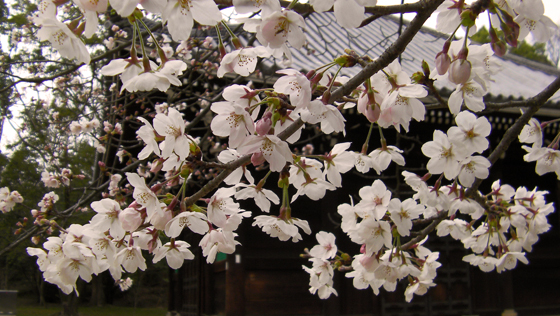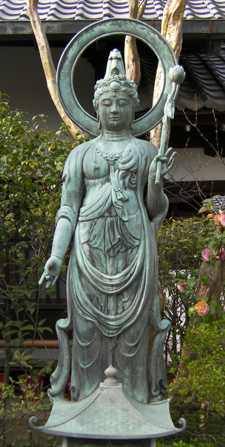
The sun sets on cherry blossoms at Ninnaji Temple near the start of the hanami season…
A visit to the Myoshinji Temple (妙心寺) complex and surrounding area during cherry blossom season is a great way to see some of Kyoto’s most bountiful displays of flowers, culture load on national treasures and World Heritage stuff and generally enjoy the start of the lighter Spring weather. While everything is located close together, the route below still involves some wandering and could easily fill the better part of an afternoon.
For anyone interested in Zen, Myoshinji is the headquarters of the largest school of Rinzai Zen and offers various ways to experience guided meditation, temple stays and related activities. Details can be found on both the Myoshinji and Taizoin Web sites.
Taizoin Temple
Taizoin (退蔵院) is the oldest and most well known of the 30-plus sub-temples in the complex and even in early Spring, its lush gardens offer quite a contrast to Myoshinji’s slightly less well tended paths. Taizoin only actually has a few cherry trees but the large weeping shidare-zakura that forms the centerpiece of the karesansui dry rock garden is spectacular as you turn to enter through the low gate.
As you move through into the second connected garden with the large pool, there are more trees, including several in a side area where you can take tea if you are feeling contemplative. Taizoin also offers various other attractive gardens and things Zen, which are introduced in detail on its well maintained English Web site.

Statue at Taizoin Temple
Ninnaji Temple
Before heading to Ninnaji (仁和寺), spend some time strolling through Myoshinji’s sprawling grounds. A number of the other temples are open to the public, have their own large sakura and, unlike Taizoin, are virtually deserted. This will also make you feel better if you, as I did last time, arrive at Ninnaji and find that while the lightly colored somei-yoshino are looking radiant, the main orchard is only just coming into bud.
On the up side, there appears to be some major work going on to buff up Ninnaji’s main buildings, in addition to the Shinden, which will hopefully restore a little more of the presence befitting a World Heritage Site. Just for the record, Ninnaji is actually the headquarters of the Omuro School of Shingon Buddhism and also offers temple stays, should you wish to hang with the monks.
Ryoanji Temple
Ryoanji (龍安寺) was the last stop on my tour mostly because I hadn’t visited Taizoin before. But I really enjoy strolling the spacious grounds with their atmospheric, winding paths and abundant foliage and would suggest visiting here first if you are crunched for time. The sign posting to the other temples is also a lot easier to follow than from Taizoin.
Ryoanji is world (heritage site) famous for its karesansui rock garden but while the back wall is draped by a most pleasing tree, if you are here for the sakura, you will want to save time for the Kyoyochi Pond water garden and surrounding area. This is also the place to see the bright, fresh greens and flowers such as camellias that are an important part of the Spring landscape in Japan.
Resources and other details
Myoshinji Temple: Japanese Web site, English Web site and map of the grounds (Japanese)
Taizoin Temple: Japanese Web site and English Web site
Ninnaji Temple: Japanese Web site and English Web site
Ryoanji Temple: Japanese Web site and English Web siteHanazono Station on the JR Sagano Line provides the easiest access to Taizoin (transferring at Nijo on the subway’s Tozai Line). Myoshinji is not well sign posted from Hanazono but if you turn right out of the station, you should see it after about five minutes. Taizoin is inside the main gate on the left side.
Once you leave Taizoin, head left toward the far side of the grounds. There is a map with English names on the right just outside the gate. To head directly to Ryoanji, take the road behind you as you face the map. For Ninnaji, follow the road on the right up and around to the main road, which also connects the two temples.
It is probably most convenient to return from Ryoanji by bus but the Keifuku Kitano Line, boarding at Ryoanjimichi Station, is more scenic.

How much longer do you think the hanami lasts? I’ll probably be pasisng thru Kyoto in a couple days.
You should be just in time for Myoshinji, at least. The blossoms are basically finished in the city but I’ve heard Taizoin is still looking good and the orchard at Ninnaji should also be fine for a while.